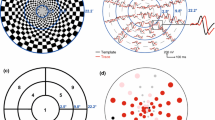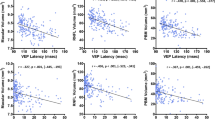Abstract
Multi-flash campimetry is a computer-implemented psychophysical technique that allows a rapid and extensive assessment of visual flicker sensitivity. Multi-flash field maps generated from the data typically reveal the presence of ‘islands’ of degraded temporal resolution in multiple sclerosis (MS) patients, but not in normal control observers. These distinct ‘islands’ presumably reflect the influence of demyelination as well as a variety of other possible transient factors, such as edema and inflammation of the optic nerve. The question addressed in the present study concerned a means of distinguishing among such influences.
The strategy employed was to test MS patients more than once over a period of several months. Under the assumption that there is little or no significant remyelination in the central nervous system, it was argued that ‘islands’ that remain present over time should be those that principally reflect demyelination. Transient changes that appear in the fields of MS patients probably reflect the influence of other mediating factors. Examples of multi-flash field maps are presented to illustrate this point and to serve as an initial assessment of the reliability of the technique. It is concluded that multi-flash campimetry may prove to be an effective aid in documenting the degree of progressive visual involvement in MS, and provide a means of monitoring the clinical course of demyelination in the visual system.
Similar content being viewed by others
References
Allt, G. Remyelination in the central nervous system. Trends Neurosci. 2: 226 (1979).
Bostock, H. & T.A. Sears. Continuous conduction in demyelinated mammalian nerve fibers. Nature 263: 786–787 (1976).
Bostock, H. & T.A. Sears. The internodal axon membrane: Electrical excitability and continuous conduction in segmental demyelination. J. Physiol 280: 273–301 (1978).
Brussell, E.M., C.W. White, M. Bross, P. Mustillo & M. Borenstein. Multi-flash campimetry in multiple sclerosis. Curr. Eye Res. 1: 671–677 (1981/1982).
Daley, M.L., R.L. Swank & C.M. Ellison. Flicker fusion thresholds in multiple sclerosis: A functional measure of neurological damage. Arch. Neurol. 36: 292–295 (1979).
De Weerd, A. Evoked potential changes in clinically definite multiple sclerosis. J. Neurol. Neurosurg. Psychiat. 45: 1075 (1982).
Galvin, R.J., J.R. Heron & D. Regan. Subclinical optic neuropathy in multiple sclerosis. Arch. Neurol. 34: 666–670 (1977).
Galvin, R.J., D. Regan & Heron, Jr. Impaired temporal resolution of vision after acute retrobulbar neuritis. Brain 99: 255–268 (1976).
Halliday, A.M. & W.I. McDonald. Pathophysiology of demyelinating disease. Br. Med. Bull. 33: 21–27 (1977).
Heron, J.R., D. Regan & B.A. Milner. Delay of visual perception in unilateral optic atrophy after retobulbar neuritis. Brain 97: 69–78 (1974).
Korol, S. Périmétrie du délai et sclérose en plaques. Bull. Soc. Belge Ophtalmol. 199–200: 117–123 (1982).
Lumsden, C.E. Multiple sclerosis and other demyelinating diseases. In: Vinken, P.J. & G.W. Bruyn, eds. Handbook of clinical neurology, vol. 9. North Holland, Amsterdam, pp. 234–247 (1970).
McDonald, W.I. Remyelination in relation to clinical lesions of the central nervous system. Br. Med. Bull. 30: 186–189 (1974).
Parsons, O.A. & P.N. Miller. Flicker fusion thresholds in multiple sclerosis. Arch. Neurol. Psychiat. 77: 134–139 (1957).
Patterson, V.H., D.H. Foster, J.R. Heron & R.J. Mason. Multiple sclerosis: luminance threshold and measurements of temporal characteristics of vision. Arch. Neurol. 38:687–689 (1981).
Regan, D. Detection and quantification of neuroophthalmological abnormalities using psychophysical measures of visual delay and temporal resolution. In: Sokol, S., ed. Electrophysiology and psychophysics: Their use in ophthalmic diagnosis. Little-Brown, Boston, pp. 185–204 (1980).
Regan, D. Visual psychophysical tests in multiple sclerosis as an aid to diagnosis, localization of pathology, and assessment of experimental therapy. In: Clinical applications of visual psychophysics. Proenza, L.M., J.M. Enoch & A. Jampolsky, eds. Cambridge University Press, New York, pp. 234–272 (1981).
Regan, D. Visual psychophysical tests in the diagnosis of multiple sclerosis. In: Diagnosis of multiple sclerosis. Poser, C.M., ed. Thieme-Stratton, New York (in press).
Regan, D., B.A. Milner & J.R. Heron. Delayed visual perception and delayed visual evoked potentials in the spinal form of multiple sclerosis and in retrobulbar neuritis. Brain 99: 43–66 (1976).
Regan, D., R. Silver & T.J. Murray. Visual acuity and contrast sensitivity in multiple sclerosis: Hidden visual loss. Brain 100: 563–579 (1977).
Regan, D., S. Bartol, T.J. Murray & K.I. Beverley. Spatial frequency discrimination in normal vision and in patients with multiple sclerosis. Brain 105: 735–754 (1982).
Regan, D., J. Raymond, A.P. Ginsburg & T.J. Murray. Contrast sensitivity, visual acuity and the discrimination of Snellen letters in multiple sclerosis. Brain 104: 333–350 (1981).
Titcombe, A.F. & B.G. Willison. Flicker fusion in multiple sclerosis. J. Neurol. Neurosurg. Psychiat. 24: 260–265 (1961).
Waxman, S.G. Clinicopathological correlations in multiple sclerosis and related diseases. In: Waxman, S.G. & J.M. Ritchie, eds. Demyelinating disease: Basic and clinical electrophysiology. Raven Press, New York, pp. 169–192 (1981).
Waxman, S.G. Membranes, myelin, and the pathophysiology of multiple sclerosis. N. Engl. J. Med. 306: 1529–1533 (1982).
Waxman, S.G. & M.H. Brill. Conduction through demyelinated plaques in multiple sclerosis: Computer simulations of facilitation by short internodes. J. Neurol. Neurosurg. Psychiat. 41: 408–416 (1978).
White, C.W., E.M. Brussell, O. Overbury & P. Mustillo. Assessment of temporal resolution in multiple sclerosis by multi-flash campimetry. In: Breinin, G.M. & I.M. Siegel, eds. Advances in diagnostic visual optics. Springer-Verlag, Berlin, pp. 239–246 (1983).
Author information
Authors and Affiliations
Rights and permissions
About this article
Cite this article
Mustillo, P., Brussell, E.M., White, C.W. et al. Monitoring demyelination in multiple sclerosis with multi-flash campimetry. Int Ophthalmol 7, 75–86 (1984). https://doi.org/10.1007/BF00165108
Issue Date:
DOI: https://doi.org/10.1007/BF00165108




